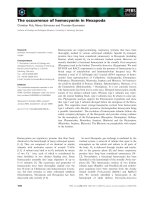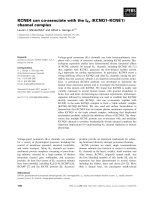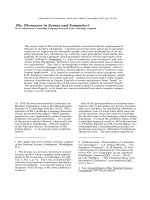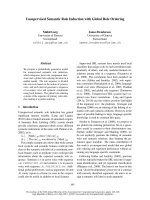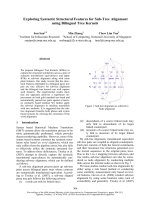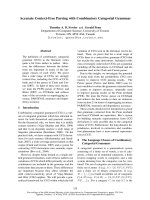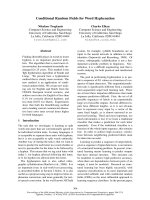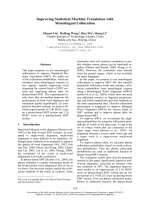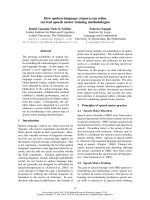Tài liệu Báo cáo khoa học: "Large-Scale Syntactic Language Modeling with Treelets" docx
Bạn đang xem bản rút gọn của tài liệu. Xem và tải ngay bản đầy đủ của tài liệu tại đây (298.29 KB, 10 trang )
Proceedings of the 50th Annual Meeting of the Association for Computational Linguistics, pages 959–968,
Jeju, Republic of Korea, 8-14 July 2012.
c
2012 Association for Computational Linguistics
Large-Scale Syntactic Language Modeling with Treelets
Adam Pauls Dan Klein
Computer Science Division
University of California, Berkeley
Berkeley, CA 94720, USA
{adpauls,klein}@cs.berkeley.edu
Abstract
We propose a simple generative, syntactic
language model that conditions on overlap-
ping windows of tree context (or treelets) in
the same way that n-gram language models
condition on overlapping windows of linear
context. We estimate the parameters of our
model by collecting counts from automati-
cally parsed text using standard n-gram lan-
guage model estimation techniques, allowing
us to train a model on over one billion tokens
of data using a single machine in a matter of
hours. We evaluate on perplexity and a range
of grammaticality tasks, and find that we per-
form as well or better than n-gram models and
other generative baselines. Our model even
competes with state-of-the-art discriminative
models hand-designed for the grammaticality
tasks, despite training on positive data alone.
We also show fluency improvements in a pre-
liminary machine translation experiment.
1 Introduction
N-gram language models are a central component
of all speech recognition and machine translation
systems, and a great deal of research centers around
refining models (Chen and Goodman, 1998), ef-
ficient storage (Pauls and Klein, 2011; Heafield,
2011), and integration into decoders (Koehn, 2004;
Chiang, 2005). At the same time, because n-gram
language models only condition on a local window
of linear word-level context, they are poor models of
long-range syntactic dependencies. Although sev-
eral lines of work have proposed generative syntac-
tic language models that improve on n-gram mod-
els for moderate amounts of data (Chelba, 1997; Xu
et al., 2002; Charniak, 2001; Hall, 2004; Roark,
2004), these models have only recently been scaled
to the impressive amounts of data routinely used by
n-gram language models (Tan et al., 2011).
In this paper, we describe a generative, syntac-
tic language model that conditions on local con-
text treelets
1
in a parse tree, backing off to smaller
treelets as necessary. Our model can be trained sim-
ply by collecting counts and using the same smooth-
ing techniques normally applied to n-gram mod-
els (Kneser and Ney, 1995), enabling us to apply
techniques developed for scaling n-gram models out
of the box (Brants et al., 2007; Pauls and Klein,
2011). The simplicity of our training procedure al-
lows us to train a model on a billion tokens of data in
a matter of hours on a single machine, which com-
pares favorably to the more involved training algo-
rithm of Tan et al. (2011), who use a two-pass EM
training algorithm that takes several days on several
hundred CPUs using similar amounts of data.
The simplicity of our approach also contrasts with
recent work on language modeling with tree sub-
stitution grammars (Post and Gildea, 2009), where
larger treelet contexts are incorporated by using so-
phisticated priors to learn a segmentation of parse
trees. Such an approach implicitly assumes that a
“correct” segmentation exists, but it is not clear that
this is true in practice. Instead, we build upon the
success of n-gram language models, which do not
assume a segmentation and instead score all over-
lapping contexts.
We evaluate our model in terms of perplexity, and
show that we achieve the same performance as a
state-of-the-art n-gram model. We also evaluate our
model on several grammaticality tasks proposed in
1
We borrow the term treelet from Quirk et al. (2005), who
use it to refer to an arbitrary connected subgraph of a tree.
959
(a) The index fell 109.85 Monday . (b) ROOT
S-VBDˆROOT
NP-NN
DT-the
The
NN
index
VP-VBDˆS
VBD
fell
CD-DC
109.85
NNTP
Monday
.
.
(c) ROOT
S-VBDˆROOT
NP-NN
DT-the
The
NN
index
VP-VBDˆS
VBD
fell
CD-DC
109.85
NNTP
Monday
.
.
5-GRAM
The board ’s will soon be feasible , from everyday which Coke ’s cabinet hotels .
They are all priced became regulatory action by difficulty caused nor Aug. 31 of Helmsley-Spear :
Lakeland , it may take them if the 46-year-old said the loss of the Japanese executives at him :
But 8.32 % stake in and Rep. any money for you got from several months , ” he says .
TREELET
Why a $ 1.2 million investment in various types of the bulk of TVS E. August ?
“ One operating price position has a system that has Quartet for the first time , ” he said .
He may enable drops to take , but will hardly revive the rush to develop two-stroke calculations . ”
The centers are losses of meals , and the runs are willing to like them .
Table 1: The first four samples of length between 15 and 20 generated from the 5-GRAM and TREELET models.
rule context would need its own state in the gram-
mar), and extensive pruning would be in order.
In practice, however, language models are nor-
mally integrated into a decoder, a non-trivial task
that is highly problem-dependent and beyond the
scope of this paper. However, we note that for
machine translation, a model that builds target-side
constituency parses, such as that of Galley et al.
(2006), combined with an efficient pruning strategy
like cube pruning (Chiang, 2005), should be able to
integrate our model without much difficulty.
That said, for evaluation purposes, whenever we
need to query our model, we use the simple strategy
of parsing a sentence using a black box parser, and
summing over our model’s probabilities of the 1000-
best parses.
4
Note that the bottleneck in this case
is the parser, so our model can essentially score a
sentence at the speed of a parser.
5 Experiments
We evaluate our model along several dimensions.
We first show some sample sentences generated by
our model in Section 5.1. We report perplexity re-
4
We found that using the 1-best worked just as well as the
1000-best on our grammaticality tasks, but significantly overes-
timated our model’s perplexities.
sults in Section 5.2. In Section 5.3, we measure
its ability to distinguish between grammatical En-
glish and various types of automatically generated,
or pseudo-negative,
5
English. We report machine
translation reranking results in Section 5.4.
5.1 Generating Samples
Because our model is generative, we can qualita-
tively assess it by generating samples and verifying
that they are more syntactically coherent than other
approaches. In Table 1, we show the first four sam-
ples of length between 15 and 20 generated from
both model and a 5-gram model trained on the Penn
Treebank.
5.2 Perplexity
Perplexity is the standard intrinsic evaluation metric
for language models. It measures the inverse of the
per-word probability a model assigns to some held-
out set of grammatical English (so lower is better).
For training data, we constructed a large treebank by
concatenating the Penn Treebank, the Brown Cor-
pus, the 50K BLLIP training sentences from Post
(2011), and the AFP and APW portions of English
5
We follow Okanohara and Tsujii (2007) in using the term
pseudo-negative to highlight the fact that automatically gener-
ated negative examples might not actually be ungrammatical.
Figure 1: Conditioning contexts and back-off strategies for Markov models. The bolded symbol indicates the part of the
tree/sentence being generated, and the dotted lines represent the conditioning contexts; back-off proceeds from the largest to the
smallest context. (a) A trigram model. (b) The context used for non-terminal productions in our treelet model. For this context,
P =VP-VBDˆS, P
=S-VBDˆROOT, and r
=S-VBDˆROOT→NP-NN VP-VBDˆS . (c) The context used for terminal productions
in our treelet model. Here, P =VBD, R=CD-DC, r
=VP-VBDˆS→VBD CD-DC NNTP, w
−1
=index, and w
−2
=The. Note that the
tree is a modified version of a standard Penn Treebank parse – see Section 3 for details.
the literature (Okanohara and Tsujii, 2007; Foster et
al., 2008; Cherry and Quirk, 2008) and show that
it consistently outperforms an n-gram model as well
as other head-driven and tree-driven generative base-
lines. Our model even competes with state-of-the-art
discriminative classifiers specifically designed for
each task, despite being estimated on positive data
alone. We also show fluency improvements in a pre-
liminary machine translation reranking experiment.
2 Treelet Language Modeling
The common denominator of most n-gram language
models is that they assign probabilities roughly ac-
cording to empirical frequencies for observed n-
grams, but fall back to distributions conditioned on
smaller contexts for unobserved n-grams, as shown
in Figure 1(a). This type of smoothing is both highly
robust and easy to implement, requiring only the col-
lection of counts from data.
We would like to apply the same smoothing tech-
niques to distributions over rule yields in a con-
stituency tree, conditioned on contexts consisting
of previously generated treelets (rules, nodes, etc.).
Formally, let T be a constituency tree consisting of
context-free rules of the form r = P → C
1
· · · C
d
,
where P is the parent symbol of rule r and C
d
1
=
C
1
. . . C
d
are its children. We wish to assign proba-
bilities to trees
2
2
A distribution over trees also induces a distribution over
sentences w
1
given by p(w
1
) =
P
T :s(T )=w
1
p(T ), where
p(T ) =
r∈T
p(C
d
1
|h)
where the conditioning context h is some portion of
the already-generated parts of the tree. In this paper,
we assume that the children of a rule are expanded
from left to right, so that when generating the yield
C
d
1
, all treelets above and left of the parent P are
available. Note that a raw PCFG would condition
only on P , i.e. h = P .
As in the n-gram case, we would like to pick h
to be large enough to capture relevant dependencies,
but small enough that we can obtain meaningful es-
timates from data. We start with a straightforward
choice of context: we condition on P , as well as the
rule r
that generated P , as shown in in Figure 1(b).
Conditioning on the parent rule r
allows us to
capture several important dependencies. First, it
captures both P and its parent P
, which predicts
the distribution over child symbols far better than
just P (Johnson, 1998). Second, it captures posi-
tional effects. For example, subject and object noun
phrases (NPs) have different distributions (Klein and
Manning, 2003), and the position of an NP relative
to a verb is a good indicator of this distinction. Fi-
nally, the generation of words at preterminals can
condition on siblings, allowing the model to capture,
for example, verb subcategorization frames.
We should be clear that we are not the first
s(T ) is the terminal yield of T .
960
to use back-off-based smoothing for syntactic lan-
guage modeling – such techniques have been ap-
plied to models that condition on head-word con-
texts (Charniak, 2001; Roark, 2004; Zhang, 2009).
Parent rule context has also been employed in trans-
lation (Vaswani et al., 2011). However, to our
knowledge, we are the first to apply these techniques
for language modeling on large amounts of data.
2.1 Lexical context
Although it is tempting to think that we can replace
the left-to-right generation of n-gram models with
the purely top-down generation of typical PCFGs,
in practice, words are often highly predictive of the
words that follow them – indeed, n-gram models
would be terrible language models if this were not
the case. To capture linear effects, we extend the
context for terminal (lexical) productions to include
the previous two words w
−2
and w
−1
in the sentence
in addition to r
; see Figure 1(c) for a depiction. This
allows us to capture collocations and other lexical
correlations.
2.2 Backing off
As with n-gram models, counts for rule yields con-
ditioned on r
are sparse, and we must choose an ap-
propriate back-off strategy. We handle terminal and
non-terminal productions slightly differently.
For non-terminal productions, we back off from
r
to P and its parent P
, and then to just P .
That is, we back off from a rule-annotated gram-
mar p(C
d
1
|P, P
, r
) to a parent-annotated gram-
mar (Johnson, 1998) p(C
d
1
|P, P
), then to a raw
PCFG p(C
d
1
|P ). In order to generalize to unseen
rule yields C
d
1
, we further back off from the ba-
sic PCFG probability p(C
d
1
|P ) to p(C
i
|C
i−1
i−3
, P ), a
4-gram model over symbols C conditioned on P ,
interpolated with an unconditional 4-gram model
p(C
i
|C
i−1
i−3
). In other words, we back off from a raw
PCFG to
λ
d
i=1
p(C
i
|C
i−1
i−3
, P ) + (1 − λ)
d
i=1
p(C
i
|C
i−1
i−3
)
where λ = 0.9 is an interpolation constant.
For terminal (i.e lexical) productions, we
first remove lexical context, backing off from
p(w|P, R, r
, w
−1
, w
−2
) to p(w|P, R, r
, w
−1
) and
then p(w|P, R, r
). From there, we back off to
p(w|P, R) where R is the sibling immediately to the
right of P , then to a raw PCFG p(w|P ), and finally
to a unigram distribution. We chose this scheme be-
cause p(w|P, R) allows, for example, a verb to be
generated conditioned on the non-terminal category
of the argument it takes (since arguments usually im-
mediately follow verbs). We depict these two back-
off schemes pictorially in Figure 1(b) and (c).
2.3 Estimation
Estimating the probabilities in our model can be
done very simply using the same techniques (in fact,
the same code) used to estimate n-gram language
models. Our model requires estimates of four distri-
butions: p(C
d
1
|P, P
, r
), p(w|P, R, r
, w
−1
, w
−2
),
p(C
i
|C
i−1
i−n+1
, P ), and p(C
i
|C
i−1
i−n+1
). In each case,
we require empirical counts of treelet tuples in the
same way that we require counts of word tuples for
estimating n-gram language models.
There is one additional hurdle in the estimation of
our model: while there exist corpora with human-
annotated constituency parses like the Penn Tree-
bank (Marcus et al., 1993), these corpora are quite
small – on the order of millions of tokens – and we
cannot gather nearly as many counts as we can for n-
grams, for which billions or even trillions (Brants et
al., 2007) of tokens are available on the Web. How-
ever, we can use one of several high-quality con-
stituency parsers (Collins, 1997; Charniak, 2000;
Petrov et al., 2006) to automatically generate parses.
These parses may contain errors, but not all parsing
errors are problematic for our model, since we only
care about the sentences generated by our model and
not the parses themselves. We show in our experi-
ments that the addition of data with automatic parses
does improve the performance of our language mod-
els across a range of tasks.
3 Tree Transformations
In the previous section, we described how to condi-
tion on rich parse context to better capture the dis-
tribution of English trees. While such context al-
lows our model to capture many interesting depen-
dencies, several important dependencies require ad-
ditional attention. In this section, we describe a
961
ROOT
S-VBˆROOT
PRP-he
He
VP-VBˆS
VB
reset
NP-NNS
JJ
opening
NNS
arguments
PP-for
IN-for
for
NNT
today
.
.
Figure 2: A sample parse from the Penn Treebank after
the tree transformations described in Section 3. Note that
we have not shown head tag annotations on preterminals
because in that case, the head tag is the preterminal itself.
number of transformations of Treebank constituency
parses that allow us to capture such dependencies.
We list the annotations and deletions in the order in
which they are performed. A sample transformed
tree is shown in Figure 2.
Temporal NPs Following Klein and Manning (2003),
we attempt to annotate temporal noun phrases. Although
the Penn Treebank annotates temporal NPs, most off-the-
shelf parsers do not retain these tags, and we do not as-
sume their presence. Instead, we mark any noun that is
the head of a NP-TMP constituent at least once in the
Treebank as a temporal noun, so for example today would
be tagged as NNT and months would be tagged as NNTS.
Head Annotations We annotate every non-terminal or
preterminal with its head word if the head is a closed-
class word
3
and with its head tag otherwise. Klein and
Manning (2003) used head tag annotation extensively,
though they applied their splits much more selectively.
NP Flattening We delete NPs dominated by
other NPs, unless the child NPs are in coordi-
nation or apposition. These NPs typically oc-
cur when nouns are modified by PPs, as in
(
NP
(
NP
(
NN
stock) (
NNS
sales)) (
PP
(
IN
by) (
NNS
traders))). By
removing the dominated NP, we allow the production
NNS→sales to condition on the presence of a modifying
PP (here a PP head-annotated with by).
Number Annotations Numbers are divided into five
classes: CD-YR for numbers that consist of four digits
(which are usually years); CD-NM for entirely numeric
numbers; CD-DC for numbers that have a decimal; CD-
3
We define the following to be closed class words: any punc-
tuation; all inflections of the verbs do, be, and have; and any
word tagged with IN, WDT, PDT, WP, WP$, TO, WRB, RP,
DT, SYM, EX, POS, PRP, AUX, or CC.
MX for numbers that mix letters and digits; and CD-AL
for numbers that are entirely alphabetic.
SBAR Flattening We remove any sentential (S) nodes
immediately dominated by an SBAR. S nodes under
SBAR have very distinct distributions from other senten-
tial nodes, mostly due to empty subjects and/or objects.
VP Flattening We remove any VPs immediately domi-
nating a VP, unless it is conjoined with another VP. In the
Treebank, chains of verbs (e.g. will be going) have a sep-
arate VP for each verb. By flattening such structures, we
allow the main verb and its arguments to condition on the
whole chain of verbs. This effect is particularly important
for passive constructions.
Gapped Sentence Annotation Collins (1999) and
Klein and Manning (2003) annotate nodes which have
empty subjects. Because we only assume the presence
of automatically derived parses, which do not produce
the empty elements in the original Treebank, we must
identify such elements on our own. We use a very simple
procedure: we annotate all S or SBAR nodes that have a
VP before any NPs.
Parent Annotation We annotate all VPs with their par-
ent symbol. Because our treelet model already conditions
on the parent, this has the effect of allowing verbs to con-
dition on their grandparents. This was important for VPs
under SBAR nodes, which often have empty objects. We
also parent-annotated any child of the ROOT.
Unary Deletion We remove all unary productions ex-
cept the root and preterminal productions, keeping only
the bottom-most symbol. Because we are not interested
in the internal labels of the trees, unaries are largely a
nuisance, and their removal brings many symbols into the
context of others.
4 Scoring a Sentence
Computing the probability of a sentence w
1
under
our model requires summing over all possible parses
of w
1
. Although our model can be formulated as a
straightforward PCFG, allowing O(
3
) computation
of this sum, the grammar constant for this PCFG
would be unmanageably large (since every parent
rule context would need its own state in the gram-
mar), and extensive pruning would be in order.
In practice, however, language models are nor-
mally integrated into a decoder, a non-trivial task
that is highly problem-dependent and beyond the
scope of this paper. For machine translation, a model
that builds target-side constituency parses, such as
that of Galley et al. (2006), combined with an ef-
ficient pruning strategy like cube pruning (Chiang,
962
5-GRAM
The board ’s will soon be feasible , from everyday which Coke ’s cabinet hotels .
They are all priced became regulatory action by difficulty caused nor Aug. 31 of Helmsley-Spear :
Lakeland , it may take them if the 46-year-old said the loss of the Japanese executives at him :
But 8.32 % stake in and Rep. any money for you got from several months , ” he says .
TREELET
Why a $ 1.2 million investment in various types of the bulk of TVS E. August ?
“ One operating price position has a system that has Quartet for the first time , ” he said .
He may enable drops to take , but will hardly revive the rush to develop two-stroke calculations . ”
The centers are losses of meals , and the runs are willing to like them .
Table 1: The first four samples of length between 15 and 20 generated from the 5-GRAM and TREELET models.
2005), should be able to integrate our model without
much difficulty.
That said, for evaluation purposes, whenever we
need to query our model, we use the simple strategy
of parsing a sentence using a black box parser, and
summing over our model’s probabilities of the 1000-
best parses.
4
Note that the bottleneck in this case
is the parser, so our model can essentially score a
sentence at the speed of a parser.
5 Experiments
We evaluate our model along several dimensions.
We first show some sample generated sentences in
Section 5.1. We report perplexity results in Sec-
tion 5.2. In Section 5.3, we measure its ability to
distinguish between grammatical English and var-
ious types of automatically generated, or pseudo-
negative,
5
English. We report machine translation
reranking results in Section 5.4.
5.1 Generating Samples
Because our model is generative, we can qualita-
tively assess it by generating samples and verifying
that they are more syntactically coherent than other
approaches. In Table 1, we show the first four sam-
ples of length between 15 and 20 generated from our
model and a 5-gram model trained on the Penn Tree-
bank.
4
We found that using the 1-best worked just as well as the
1000-best on our grammaticality tasks, but significantly overes-
timated our model’s perplexities.
5
We follow Okanohara and Tsujii (2007) in using the term
pseudo-negative to highlight the fact that automatically gener-
ated negative examples might not actually be ungrammatical.
5.2 Perplexity
Perplexity is the standard intrinsic evaluation metric
for language models. It measures the inverse of the
per-word probability a model assigns to some held-
out set of grammatical English (so lower is better).
For training data, we constructed a large treebank by
concatenating the WSJ and Brown portions of the
Penn Treebank, the 50K BLLIP training sentences
from Post (2011), and the AFP and APW portions
of English Gigaword version 3 (Graff, 2003), total-
ing about 1.3 billion tokens. We used the human-
annotated parses for the sentences in the Penn Tree-
bank, but parsed the Gigaword and BLLIP sentences
with the Berkeley Parser. Hereafter, we refer to this
training data as our 1B corpus. We used Section 0
of the WSJ as our test corpus. Results are shown in
Table 2. In addition to our TREELET model, we also
show results for the following baselines:
5-GRAM A 5-gram interpolated Kneser-Ney model.
PCFG-LA The Berkeley Parser in language model mode.
HEADLEX A head-lexicalized model similar to, but
more powerful
6
than, Collins Model 1 (Collins, 1999).
PCFG A raw PCFG.
TREELET-TRANS A PCFG estimated on the trees after
the transformations of Section 3.
TREELET-RULE The TREELET-TRANS model with the
parent rule context described in Section 2. This is equiv-
alent to the full TREELET model without the lexical con-
text described in Section 2.1.
6
Specifically, like Collins Model 1, we generate a rule yield
conditioned on parent symbol P and head word h by first gen-
erating its head symbol C
h
, then generating the head words and
symbols for left and right modifiers outwards from C
h
. Unlike
Model 1, which generates each modifier head and symbol con-
ditioned only on C
h
, h, and P , we additionally condition on the
previously generated modifier’s head and symbol and back off
to Model 1.
963
Model Perplexity
PCFG 1772
TREELET-TRANS 722
TREELET-RULE 329
TREELET 198
†
PCFG-LA 330**
HEADLEX 299
5-GRAM 207
†
Table 2: Perplexity of several generative models on Sec-
tion 0 of the WSJ. The differences between scores marked
with
†
are not statistically significant. PCFG-LA (marked
with **) was only trained on the WSJ and Brown corpora
because it does not scale to large amounts of data.
We used the Berkeley LM toolkit (Pauls
and Klein, 2011), which implements Kneser-Ney
smoothing, to estimate all back-off models for both
n-gram and treelet models. To deal with unknown
words, we use the following strategy: after the first
10000 sentences, whenever we see a new word in
our training data, we replace it with a signature
7
10% of the time.
Our model outperforms all other generative mod-
els, though the improvement over the n-gram model
is not statistically significant. Note that because we
use a k-best approximation for the sum over trees,
all perplexities (except for PCFG-LA and 5-GRAM)
are pessimistic bounds.
5.3 Classification of Pseudo-Negative Sentences
We make use of three kinds of automatically gener-
ated pseudo-negative sentences previously proposed
in the literature: Okanohara and Tsujii (2007) pro-
posed generating pseudo-negative examples from a
trigram language model; Foster et al. (2008) create
“noisy” sentences by automatically inserting a sin-
gle error into grammatical sentences with a script
that randomly deletes, inserts, or misspells a word;
and Och et al. (2004) and Cherry and Quirk (2008)
both use the 1-best output of a machine translation
system. Examples of these three types of pseudo-
negative data are shown in Table 3. We evaluate our
model’s ability to distinguish positive from pseudo-
negative data, and compare against generative base-
lines and state-of-the-art discriminative methods.
7
We use signatures generated by the Berkeley Parser.
These signatures capture surface features such as capitalization,
presents of digits, and common suffixes. For example, the word
vexing would be replaced with the signature UNK-ing.
Noisy There was were many contributors.
Trigram For years in dealer immediately .
MT we must further steps .
Table 3: Sample pseudo-negative sentences.
We would like to use our model to make grammat-
icality judgements, but as a generative model it can
only provide us with probabilities. Simply thresh-
olding generative probabilities, even with a separate
threshold for each length, has been shown to be very
ineffective for grammaticality judgements, both for
n-gram and syntactic language models (Cherry and
Quirk, 2008; Post, 2011). We used a simple measure
for isolating the syntactic likelihood of a sentence:
we take the log-probability under our model and
subtract the log-probability under a unigram model,
then normalize by the length of the sentence.
8
This
measure, which we call the syntactic log-odds ratio
(SLR), is a crude way of “subtracting out” the se-
mantic component of the generative probability, so
that sentences that use rare words are not penalized
for doing so.
5.3.1 Trigram Classification
To facilitate comparison with previous work, we
used the same negative corpora as Post (2011) for
trigram classification. They randomly selected 50K
train, 3K development, and 3K positive test sen-
tences from the BLLIP corpus, then trained a tri-
gram model on 450K BLLIP sentences and gener-
ated 50K train, 3K development, and 3K negative
sentences. We parsed the 50K positive training ex-
amples of Post (2011) with the Berkeley Parser and
used the resulting treebank to train a treelet language
model. We set an SLR threshold for each model on
the 6K positive and negative development sentences.
Results are shown in Table 4. In addition to our
generative baselines, we show results for the dis-
criminative models reported in Cherry and Quirk
(2008) and Post (2011). The former train a latent
PCFG support vector machine for binary classifica-
tion (LSVM). The latter report results for two bi-
nary classifiers: RERANK uses the reranking fea-
tures of Charniak and Johnson (2005), and TSG uses
8
Och et al. (2004) also report using a parser probability nor-
malized by the unigram probability (but not length), and did not
find it effective. We assume this is either because the length-
normalization is important, or because their choice of syntactic
language model was poor.
964
Generative
BLLIP 1B
PCFG 81.5 81.8
TREELET-TRANS 87.7 90.1
TREELET-RULE 89.8 94.1
TREELET 88.9 93.3
PCFG-LA 87.1* –
HEADLEX 87.6 92.0
5-GRAM 67.9 87.5
Discriminative
BLLIP 1B
LSVM 81.42** –
TSG 89.9 –
RERANK 93.0 –
Table 4: Classification accuracy for trigram pseudo-negative
sentences on the BLLIP corpus. The number reported for
PCFG-LA is marked with a * to indicate that this model was
trained on the training section of the WSJ, not the BLLIP cor-
pus. The number reported for LSVM (marked with **) was eval-
uated on a different random split of the BLLIP corpus, and so is
not directly comparable.
indicator features extracted from a tree substitution
grammar derivation of each sentence.
Our TREELET model performs nearly as well as
the TSG method, and substantially outperforms the
LSVM method, though the latter was not tested on
the same random split. Interestingly, the TREELET-
RULE baseline, which removes lexical context from
our model, outperforms the full model. This is likely
because the negative data is largely coherent at the
trigram level (because it was generated from a tri-
gram model), and the full model is much more sen-
sitive to trigram coherence than the TREELET-RULE
model. This also explains the poor performance of
the 5-GRAM model.
We emphasize that the discriminative baselines
are specifically trained to separate trigram text from
natural English, while our model is trained on pos-
itive examples alone. Indeed, the methods in Post
(2011) are simple binary classifiers, and it is not
clear that these models would be properly calibrated
for any other task, such as integration in a decoder.
One of the design goals of our system was that
it be scalable. Unlike some of the discriminative
baselines, which require expensive operations
9
on
9
It is true that in order train our system, one must parse large
amounts of training data, which can be costly, though it only
needs to be done once. In contrast, even with observed train-
ing trees, the discriminative algorithms must still iteratively per-
form expensive operations (like parsing) for each sentence, and
a new model must be trained for new types of negative data.
Model Pairwise Independent
WSJ 1B WSJ 1B
PCFG 79.1 77.0 58.9 58.6
TREELET-RULE 90.3 94.4 63.8 66.2
TREELET 90.7 94.5 63.4 65.5
5-GRAM 86.3 93.5 55.7 60.1
HEADLEX 90.7 94.0 59.5 62.0
PCFG-LA 91.3 – 59.7 –
Foster et al. (2008) – – 65.9 –
Table 5: Classification accuracies on the noisy WSJ for mod-
els trained on WSJ Sections 2-21 and our 1B token corpus.
“Pairwise” accuracy is the fraction of correct sentences whose
SLR score was higher than its noisy version, and “independent”
refers to standard binary classification accuracy.
each training sentence, we can very easily scale
our model to much larger amounts of data. In Ta-
ble 4, we also show the performance of the gener-
ative models trained on our 1B corpus. All gener-
ative models improve, but TREELET-RULE remains
the best, now outperforming the RERANK system,
though of course it is likely that RERANK would im-
prove if it could be scaled up to more training data.
5.3.2 “Noisy” Classification
We also evaluate the performance of our model
on the task of distinguishing the noisy WSJ sen-
tences of Foster et al. (2008) from their original
versions. We use the noisy versions of Section 0
and 23 produced by their error-generating proce-
dure. Because they only report classification re-
sults on Section 0, we used Section 23 to tune an
SLR threshold, and tested our model on Section 0.
We show the results of both independent and pair-
wise classification for the WSJ and 1B training sets
in Table 5. Note that independent classification is
much more difficult than for the trigram data, be-
cause sentences contain at most one change, which
may not even result in an ungrammaticality. Again,
our model outperforms the n-gram model for both
types of classification, and achieves the same per-
formance as the discriminative system of Foster et
al. (2008), which is state-of-the-art for this data set.
The TREELET-RULE system again slightly outper-
forms the full TREELET model at independent clas-
sification, though not at pairwise classification. This
probably reflects the fact that semantic coherence
can still influence the SLR score, despite our efforts
to subtract it out. Because the TREELET model in-
cludes lexical context, it is more sensitive to seman-
965
French German Chinese
5-GRAM 44.8 37.8 60.0
TREELET 57.9 66.0 83.8
Table 6: Pairwise comparison accuracy of MT output
against a reference translation for French, German, and
Chinese. The BLEU scores for these outputs are 32.7,
27.8, and 20.8. This task becomes easier, at least for our
TREELET model, as translation quality drops. Cherry and
Quirk (2008) report an accuracy of 71.9% on a similar
experiment with German a source language, though the
translation system and training data were different so the
numbers are not comparable. In particular, their transla-
tions had a lower BLEU score, making their task easier.
tic coherence and thus more likely to misclassify
semantically coherent but ungrammatical sentences.
For pairwise comparisons, where semantic coher-
ence is effectively held constant, such sentences are
not problematic.
5.3.3 Machine Translation Classification
We follow Och et al. (2004) and Cherry and Quirk
(2008) in evaluating our language models on their
ability to distinguish the 1-best output of a machine
translation system from a reference translation in a
pairwise fashion. Unfortunately, we do not have
access to the data used in those papers, so a di-
rect comparison is not possible. Instead, we col-
lected the English output of Moses (Hoang et al.,
2007), using both French and German as source lan-
guage, trained on the Europarl corpus used by WMT
2009.
10
We also collected the output of Joshua (Li
et al., 2009) trained on 500K sentences of GALE
Chinese-English parallel newswire. We trained both
our TREELET model and a 5-GRAM model on the
union of our 1B corpus and the English sides of our
parallel corpora.
In Table 6, we show the pairwise comparison ac-
curacy (using SLR) on these three corpora. We see
that our system prefers the reference much more of-
ten than the 5-GRAM language model.
11
However,
we also note that the easiness of the task is corre-
lated with the quality of translations (as measured in
BLEU score). This is not surprising – high-quality
translations are often grammatical and even a per-
10
/>11
We note that the n-gram language model used by the MT
system was much smaller than the 5-GRAM model, as they were
only trained on the English sides of their parallel data.
fect language model might not be able to differenti-
ate such translations from their references.
5.4 Machine Translation Fluency
We also carried out reranking experiments on 1000-
best lists from Moses using our syntactic language
model as a feature. We did not find that the use
of our syntactic language model made any statis-
tically significant increases in BLEU score. How-
ever, we noticed in general that the translations fa-
vored by our model were more fluent, a useful im-
provement to which BLEU is often insensitive. To
confirm this, we carried out an Amazon Mechan-
ical Turk experiment where users from the United
States were asked to compare translations using our
TREELET language model as the language model
feature to those using the 5-GRAM model.
12
We had
1000 such translation pairs rated by 4 separate Turk-
ers each. Although these two hypothesis sets had
the same BLEU score (up to statistical significance),
the Turkers preferred the output obtained using our
syntactic language model 59% of the time, indicat-
ing that our model had managed to pick out more
fluent hypotheses that nonetheless were of the same
BLEU score. This result was statistically significant
with p < 0.001 using bootstrap resampling.
6 Conclusion
We have presented a simple syntactic language
model that can be estimated using standard n-gram
smoothing techniques on large amounts of data. Our
model outperforms generative baselines on several
evaluation metrics and achieves the same perfor-
mance as state-of-the-art discriminative classifiers
specifically trained on several types of negative data.
Acknowledgments
We would like to thank David Hall for some modeling
suggestions and the anonymous reviewers for their com-
ments. We thank both Matt Post and Jennifer Foster for
providing us with their corpora. This work was partially
supported by a Google Fellowship to the first author and
by BBN under DARPA contract HR0011-12-C-0014.
12
We used translations from the baseline Moses system of
Section 5.3.3 with German as the input language. For each lan-
guage model, we took k-best lists from the baseline system and
replaced the baseline LM score with the new model’s score. We
then retrained all feature weights with MERT on the tune set,
and selected the 1-best output on the test set.
966
References
Thorsten Brants, Ashok C. Popat, Peng Xu, Franz J.
Och, Jeffrey Dean, and Google Inc. 2007. Large lan-
guage models in machine translation. In Proceedings
of the Conference on Empirical Methods in Natural
Language Processing.
Eugene Charniak and Mark Johnson. 2005. Coarse-to-
fine n-best parsing and maxent discriminative rerank-
ing. In Proceedings of the Association for Computa-
tional Linguistics.
Eugene Charniak. 2000. A maximum-entropy-inspired
parser. In Proceedings of the North American chapter
of the Association for Computational Linguistics.
Eugene Charniak. 2001. Immediate-head parsing for
language models. In Proceedings of the Association
for Computational Linguistics.
Ciprian Chelba. 1997. A structured language model. In
Proceedings of the Association for Computational Lin-
guistics.
Stanley F. Chen and Joshua Goodman. 1998. An empir-
ical study of smoothing techniques for language mod-
eling. In Proceedings of the Association for Computa-
tional Linguistics.
Colin Cherry and Chris Quirk. 2008. Discriminative,
syntactic language modeling through latent SVMs. In
Proceedings of The Association for Machine Transla-
tion in the Americas.
David Chiang. 2005. A hierarchical phrase-based model
for statistical machine translation. In The Annual Con-
ference of the Association for Computational Linguis-
tics.
Michael Collins. 1997. Three generative, lexicalised
models for statistical parsing. In Proceedings of As-
sociation for Computational Linguistics.
Michael Collins. 1999. Head-Driven Statistical Models
for Natural Language Parsing. Ph.D. thesis, Univer-
sity of Pennsylvania.
Jennifer Foster, Joachim Wagner, and Josef van Genabith.
2008. Adapting a wsj-trained parser to grammatically
noisy text. In Proceedings of the Association for Com-
putational Linguistics: Short Paper Track.
Michel Galley, Jonathan Graehl, Kevin Knight, Daniel
Marcu, Steve DeNeefe, Wei Wang, and Ignacio
Thayer. 2006. Scalable inference and training of
context-rich syntactic translation models. In The An-
nual Conference of the Association for Computational
Linguistics (ACL).
David Graff. 2003. English gigaword, version 3. In Lin-
guistic Data Consortium, Philadelphia, Catalog Num-
ber LDC2003T05.
Keith Hall. 2004. Best-first Word-lattice Parsing: Tech-
niques for Integrated Syntactic Language Modeling.
Ph.D. thesis, Brown University.
Kenneth Heafield. 2011. Kenlm: Faster and smaller
language model queries. In Proceedings of the Sixth
Workshop on Statistical Machine Translation.
Hieu Hoang, Alexandra Birch, Chris Callison-burch,
Richard Zens, Rwth Aachen, Alexandra Constantin,
Marcello Federico, Nicola Bertoldi, Chris Dyer,
Brooke Cowan, Wade Shen, Christine Moran, and On-
dej Bojar. 2007. Moses: Open source toolkit for sta-
tistical machine translation. In Proceedings of the As-
sociation for Computational Linguistics: Demonstra-
tion Session,.
Mark Johnson. 1998. PCFG models of linguistic tree
representations. Computational Linguistics, 24.
Dan Klein and Chris Manning. 2003. Accurate unlexi-
calized parsing. In Proceedings of the North American
Chapter of the Association for Computational Linguis-
tics (NAACL).
Reinhard Kneser and Hermann Ney. 1995. Improved
backing-off for m-gram language modeling. In IEEE
International Conference on Acoustics, Speech and
Signal Processing.
Philipp Koehn. 2004. Pharaoh: A beam search decoder
for phrase-based statistical machine translation mod-
els. In Proceedings of The Association for Machine
Translation in the Americas.
Zhifei Li, Chris Callison-Burch, Chris Dyer, Juri Gan-
itkevitch, Sanjeev Khudanpur, Lane Schwartz, Wren
N. G. Thornton, Jonathan Weese, and Omar F. Zaidan.
2009. Joshua: an open source toolkit for parsing-
based machine translation. In Proceedings of the
Fourth Workshop on Statistical Machine Translation.
M. Marcus, B. Santorini, and M. Marcinkiewicz. 1993.
Building a large annotated corpus of English: The
Penn Treebank. In Computational Linguistics.
Franz J. Och, Daniel Gildea, Sanjeev Khudanpur, Anoop
Sarkar, Kenji Yamada, Alex Fraser, Shankar Kumar,
Libin Shen, David Smith, Katherine Eng, Viren Jain,
Zhen Jin, and Dragomir Radev. 2004. A Smorgas-
bord of Features for Statistical Machine Translation.
In Proceedings of the North American Association for
Computational Linguistic.
Daisuke Okanohara and Jun’ichi Tsujii. 2007. A
discriminative language model with pseudo-negative
samples. In Proceedings of the Association for Com-
putational Linguistics.
Adam Pauls and Dan Klein. 2011. Faster and smaller
n-gram language models. In Proceedings of the Asso-
ciation for Computational Linguistics.
Slav Petrov, Leon Barrett, Romain Thibaux, and Dan
Klein. 2006. Learning accurate, compact, and inter-
pretable tree annotation. In Proceedings of COLING-
ACL 2006.
Matt Post and Daniel Gildea. 2009. Language model-
ing with tree substitution grammars. In Proceedings
967
of the Conference on Neural Information Processing
Systems.
Matt Post. 2011. Judging grammaticality with tree sub-
stitution grammar. In Proceedings of the Association
for Computational Linguistics: Short Paper Track.
Chris Quirk, Arul Menezes, and Colin Cherry. 2005. De-
pendency treelet translation: Syntactically informed
phrasal smt. In Proceedings of the Association of
Computational Linguistics.
Brian Roark. 2004. Probabilistic top-down parsing and
language modeling. Computational Linguistics.
Ming Tan, Wenli Zhou, Lei Zheng, and Shaojun Wang.
2011. A large scale distributed syntactic, semantic
and lexical language model for machine translation.
In Proceedings of the Association for Computational
Linguistics.
Ashish Vaswani, Haitao Mi, Liang Huang, and David
Chiang. 2011. Rule markov models for fast tree-to-
string translation. In Proceedings of the Association
for Computations Linguistics.
Peng Xu, Ciprian Chelba, and Fred Jelinek. 2002. A
study on richer syntactic dependencies for structured
language modeling. In Proceedings of the Association
for Computational Linguistics. Association for Com-
putational Linguistics.
Ying Zhang. 2009. Structured language models for sta-
tistical machine translation. Ph.D. thesis, Johns Hop-
kins University.
968
